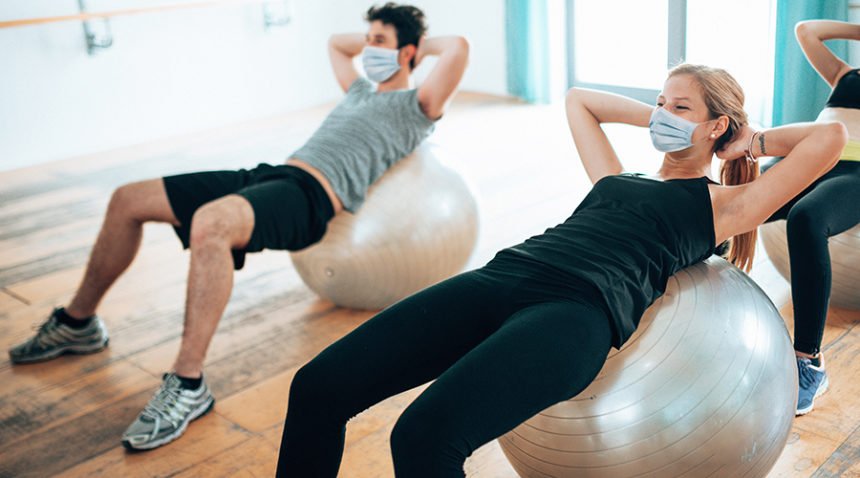If you’ve been doing online fitness classes or exercising outdoors during the COVID-19 pandemic, you may be ready to change up your routine and head back to the gym. We talked to Emily Sickbert-Bennett, PhD, director of UNC Medical Center Infection Prevention, about the steps you and your gym should take so you can do that safely.
Follow these six safety tips when you head back to the gym to pump iron, hit the yoga studio or get your heart thumping in an exercise class.
1. Get vaccinated.
COVID-19 is a very serious and dangerous virus that has killed more than 560,000 people in the United States in the past year. The COVID-19 vaccines keep you from getting severe illness and needing to go to the hospital or dying. And they’re our best bet for beating the virus and safely returning to the things we loved before the pandemic—including working out at a gym.
COVID-19 is spread mainly from person to person by respiratory droplets that are ejected when an infected person coughs, sneezes or talks.
That’s why “working out inside in close proximity to others can be risky. When you exercise hard, you breathe heavily, meaning you increase the chances of excreting those droplets onto someone else if you cannot practice physical distancing,” Dr. Sickbert-Bennett says. “You should definitely get your vaccine before you enter a group environment like a gym.”
You are considered fully vaccinated two weeks after the second dose of a two-dose vaccine (the Pfizer or Moderna vaccine) or two weeks after a single-dose vaccine (the Johnson & Johnson vaccine).
If it has been less than two weeks since your vaccine, or if you still need to get your second dose, you are not yet fully protected.
2. Wear a mask.
It’s important to wear a mask when you’re exercising close to others—even more important if you’re not vaccinated. Masks help you keep your germs to yourself by minimizing the chances of either spreading the virus or acquiring it from others.
Gyms should have clear policies about what they are doing to keep you safe and to minimize the risk of spreading the virus. Make sure your gym requires members to wear masks when working out, especially if they can’t stay 6 feet apart.
“Understand the gym’s expectations and watch to see how they handle it when people take their masks off: Are they firm in enforcing it? Do they encourage people to step outside of the building during class for a mask break if they need it?” Dr. Sickbert-Bennett says.
3. Ask if your gym limits class sizes.
Gyms need to limit class sizes so there can be adequate spacing between people while exercising. Make sure there is enough space that you can stay at least 6 feet apart from anyone else to reduce the risk of virus transmission.
“This means they may need to limit group exercises so that they can maintain distance,” Dr. Sickbert-Bennett says.
Avoid partner workouts that require you to be too close to someone else—especially if you or your partner are not vaccinated.
4. Make sure your gym disinfects equipment regularly.
If you are using shared equipment, make sure sanitizing wipes are available to wipe it down.
“In addition to COVID-19, there are all kinds of other things that can contaminate gym equipment that we worried about pre-COVID,” such as norovirus (a stomach bug) or MRSA (a drug-resistant bacteria), Dr. Sickbert-Bennett says. “So it’s good practice to have a disinfectant wipe or spray visible and available.”
Your gym should have a routine for staff to disinfect equipment.
“And they should encourage their members to do it right after they use the equipment so the equipment is clean and ready to go for someone else,” Dr. Sickbert-Bennett says.
5. Don’t go to the gym if you’re sick.
If you’re not feeling well, no matter the symptoms, stay home. Don’t risk exposing others to whatever is making you sick—whether that’s COVID-19, a stomach bug or the flu.
“Use the remote option or come back another day if you’re feeling a little bit under the weather and aren’t sure what’s going on,” Dr. Sickbert-Bennett says.
6. Wash your hands.
Remember to wash your hands thoroughly before and after your workout. Use hand sanitizer as soon as you get back in your car, and then wash your hands thoroughly again when you get home.
Also, arrive just in time for your class and leave right after; don’t spend extra time in the waiting area or locker rooms. Avoid gyms in areas that have an especially high COVID-19 rate or have seen a recent spike in cases. Take your own reusable water bottle, and don’t use your gym’s water fountains.
For the latest information on COVID-19, visit the CDC website and the UNC Health COVID-19 Resources page, and follow UNC Health on Twitter, Facebook, Instagram and YouTube. Also, visit yourshot.org for the latest information on the COVID-19 vaccines.

